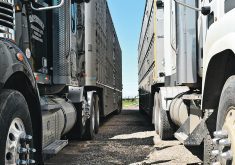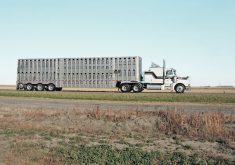In its fight against federal regulations, the industry says animal welfare should override how long cattle are in transport
Canadian cattle producers continue to be concerned about the biosecurity risks posed by transport regulations, an Ontario producer told the standing agriculture committee last week.
Matt Bowman, co-chair of the animal health and care committee at the Canadian Cattle Association, said biosecurity in the beef industry looks different than in sectors where animals are housed indoors.
Traceability measures like ear tags have been in place for years, and initiatives such as Verified Beef Production Plus training and recommended best practices are in place and cost producers more than $12.4 million.
Read Also

Saskatchewan dairy farm breeds international champion
A Saskatchewan bred cow made history at the 2025 World Dairy Expo in Madison, Wisconsin, when she was named grand champion in the five-year-old Holstein class.
“Our sector has estimated that an additional $15.9 million in initial investment and $2.3 million in ongoing costs associated with the pending traceability regulations,” he said.
He added that the transport regulations that prescribe how long animals can be on trucks raise the risk.
Bowman said the federal agriculture and transportation ministers are aware of the concerns around the use of electronic logging devices, known as ELDs, that limit drivers to 14 hours of on-duty time each day, and the requirement to unload and load cattle for rest time.
“Basically the cattle time in transport does not line up with the trucker-driver times, and that’s where the conflict arises,” he said. “How we mitigate that problem, that’s our concern right now.”
Bowman said looking to the European model as a basis for transport regulations isn’t necessarily the best idea.
“You can cover a lot of Europe by the time you get from here to Thunder Bay,” he said.
Aligning regulations with the United States would make more sense, he said, since the Americans are our largest export market.
CCA’s chief veterinary officer, Dr. Leigh Rosengren, said while it sounds good in theory, there is no scientific evidence that shorter times on a truck improve cattle welfare.
“Unfortunately, what we can show is that the rest stops, we have cattle commingling who otherwise wouldn’t have contact with each other, which is creating a theoretical and a real biosecurity risk,” she told the committee.
The theoretical risk is a foreign animal disease outbreak, such as foot-and-mouth disease.
“The real risk is we actually can show an increase in endemic pathogens in those animals who have been through the commingled sites,” she said.
Industry continues to talk to government about exceptions for animal welfare issues that might come up during a haul. They want regulations to match those in the U.S., which have some grace time to allow for loading and unloading and other delays.
Transport Canada has guidance that allows drivers to increase driving time because of adverse weather and emergencies, but doesn’t specifically list animal welfare as an emergency.
“What we need is the enforcement, which occurs at the provincial level, to be well understood, that animal welfare would fall under the guidance that allows drivers to make decisions in an emergency situation,” Rosengren said.
On biosecurity measures, Conservative agriculture critic John Barlow said the Canadian Food Inspection Agency has said it may not be equipped to deal with more than one outbreak at a time. He asked CCA to comment on CFIA’s preparedness if there was an outbreak in another livestock sector.
Bowman said CFIA addressed the CCA annual meeting in March and said dealing with avian influenza was “all that they wanted to handle at that point in time.”
Dealing with another would put them under duress.
















